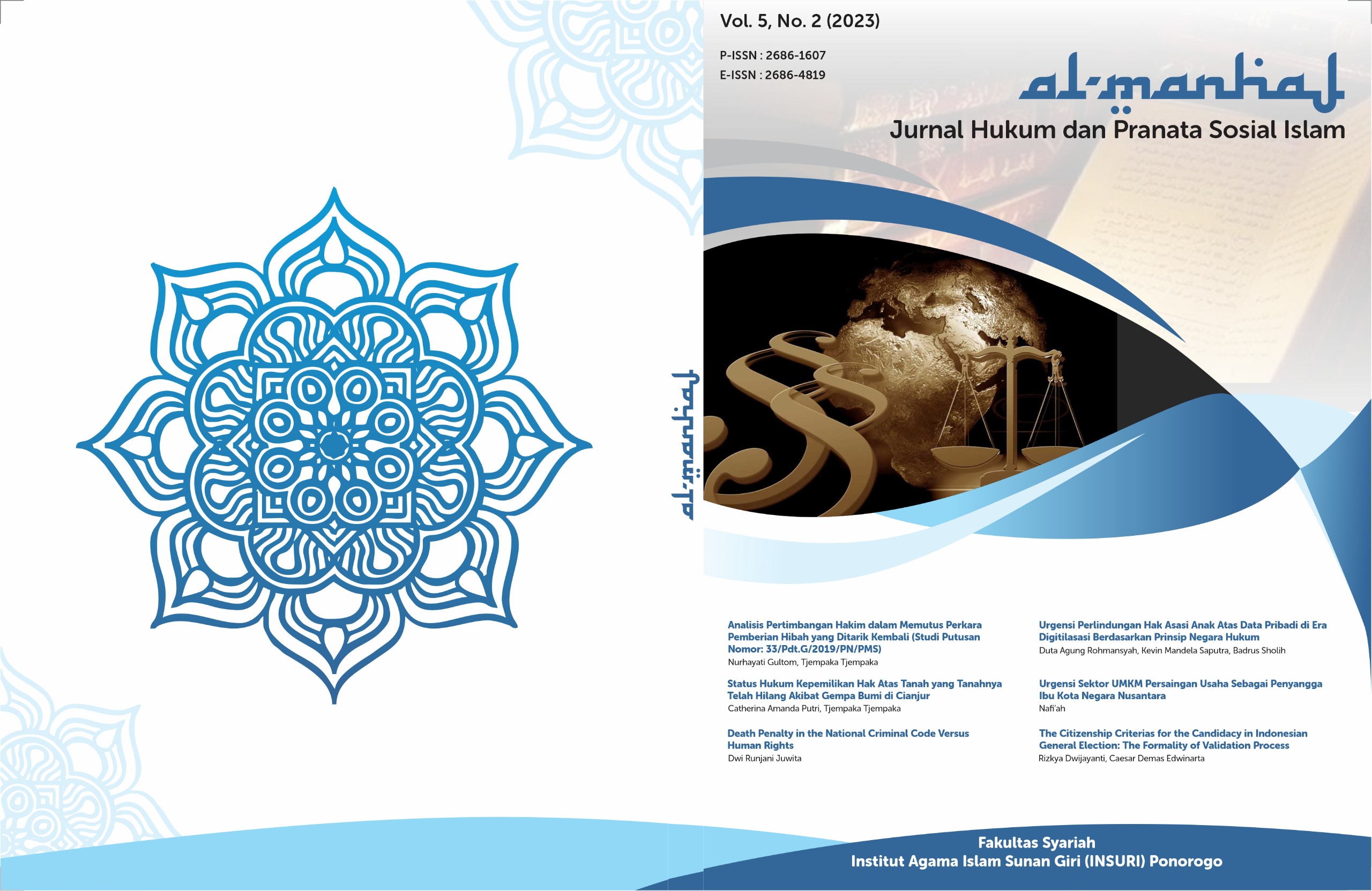Death Penalty in the National Criminal Code Versus Human Rights
DOI:
https://doi.org/10.37680/almanhaj.v5i2.2692Keywords:
Death Penalty, Criminal Code, Human RightsAbstract
Pancasila is the basis of the state in Indonesia. Countries have several types of legal rules enforced according to the crime rate of the offender. Mistakes in responding to state law lead to wrong actions. The purpose of this study is to increase legal awareness of the people in Indonesia through preventive action, namely that criminals are expected not to commit crimes because they have received a deterrent effect from punishment. Research method with normative juridical. Data analysis techniques through analysis of electronic journals, e-books and reference searches through Google Scholar. The results of the study show that the types of punishment in Indonesia have different levels according to the treatment of the crime. The heaviest consequence in serving the Death Penalty. On the basis of errors in acts of corruption and other cases. The death penalty can apply to life imprisonment, shot to death based on the judge's decision.
Downloads
References
Afif, M. (2021). Dikotomi Pidana Mati Sebagai Hak Asasi Manusia Di Indonesia Menurut Hukum Positif Dan Hukum Pidana Islam. Jurnal Gagasan Hukum, 3(01), 15–33.
Anjari, W. (2015). Penjatuhan Pidana Mati Di Indonesia Dalam Perspektif Hak Asasi Manusia. Jurnal Widya Yustisia, 1(2), 247155.
Arief, A. (2019). Problematika Penjatuhan Hukuman Pidana Mati Dalam Perspektif Hak Asasi Manusia Dan Hukum Pidana. Kosmik Hukum, 19(1).
Asnawi, H. S. (2012). Hak Asasi Manusia Islam Dan Barat: Studi Kritik Hukum Pidana Islam Dan Hukuman Mati. Supremasi Hukum: Jurnal Kajian Ilmu Hukum, 1(1).
Clarins, S. (2022). Penerapan Doktrin Penyalahgunaan Keadaan (Misbruik Van Omstandigheden) Dalam Putusan Pengadilan Indonesia. " Dharmasisya” Jurnal Program Magister Hukum Fhui, 1(4), 36.
Hamenda, V. L. (2013). Tinjauan Hak Asasi Manusia Terhadap Penerapan Hukuman Mati Di Indonesia. Lex Crimen, 2(1).
Indriyuni, A. (2020). Urgensi Penerapan Pidana Mati Di Indonesia (Telaah Terhadap Pelaku Pencurian Sepeda Motor Menggunakan Kekerasan). Muhammadiyah Law Review, 4(1), 1–13.
Kusumo, A. T. S. (2015). Hukuman Mati Ditinjau Dari Perspektif Hukum Dan Hak Asasi Manusia Internasional. Dalam Http://Ayub. Staff. Hukum. Uns. Ac. Id/Artikel-Artikel/Hukuman-Mati-Menurut-Perspektif-Ham-Internasional/, Diakses Pada, 15, 12.
Lazuady, A. Q., Da’i, R. A. N. R., & Kemuning, A. S. (2022). Konsep Ihsan Kepada Lingkungan (Suatu Kajian Awal Dalam Upaya Mewujudkan Green Environment). Jurnal Keislaman, 5(2), 218–229.
Margareta, S., & Boediningsih, W. (2023). Tanggung Gugat Korporasi Akibat Pencemaran Lingkungan Ditinjau Berdasarkan Undang-Undang Perlindungan Dan Pengelolaan Lingkungan Hidup. Jurnal Hukum Indonesia, 2(1), 1–13.
Muchinsky, P. M. (2000). Psychology Applied To Work: An Introduction To Industrial And Organizational Psychology. Wadsworth/Thomson Learning.
Pangaribuan, L. M. P. (2017). Hak Asasi Manusia. Jurnal Hukum & Pembangunan, 19(6), 519–524.
Rokhim, A. (2015). Hukuman Mati Perspektif Relativisme Hak Asasi Manusia. Jurnal Transisi” Edisi, 10, 20–40.
Sumanto, A. (2004). Kontradiksi Hukuman Mati Di Indonesia Dipandang Dari Aspek Hak Asasi Manusia, Agama Dan Para Ahli Hukum. Perspektif, 9(3), 192–215.
Wijaya, R. R. A., & Subroto, M. (2021). Analisis Hukuman Mati Di Indonesia Di Tinjau Dari Prespektif Hak Asasi Manusia. Rio Law Jurnal, 2(2), 33–42.
Yusuf, H. (2020). Sanksi Hukuman Mati Dan Perlindungan Hak Asasi Manusia Di Indonesia. Doctrinal, 2(2), 585–616.
Zulfa, E. A. (2015). Menelaah Arti Hak Untuk Hidup Sebagai Hak Asasi Manusia. Lex Jurnalica, 2(2), 17975.
Downloads
Published
How to Cite
Issue
Section
License
Copyright:
- Author retains the copyright and grants the journal the right of first publication of the work simultaneously licensed under a Creative Commons Attribution 4.0 International License that allows others to share the work with an acknowledgment of the work's authorship and initial publication in this journal.
- Author is able to enter into separate, additional contractual arrangements for the non-exclusive distribution of the journal's published version of the work (e.g., post it to an institutional repository or publish it in a book) with the acknowledgment of its initial publication in this journal.
- Author is permitted and encouraged to post his/her work online (e.g., in institutional repositories or on their website) prior to and during the submission process, as it can lead to productive exchanges, as well as earlier and greater citation of the published work (See The Effect of Open Access).
License:
-
Attribution — You must give appropriate credit, provide a link to the license, and indicate if changes were made. You may do so in any reasonable manner, but not in any way that suggests the licensor endorses you or your use.
-
No additional restrictions — You may not apply legal terms or technological measures that legally restrict others from doing anything the license permits.
You are free to:
- Share — copy and redistribute the material in any medium or format
- Adapt — remix, transform, and build upon the material for any purpose, even commercially.

This work is licensed under a Creative Commons Attribution 4.0 International License.














